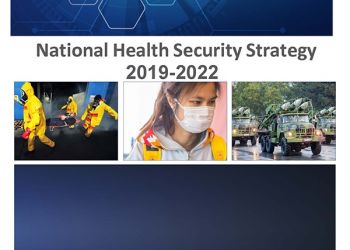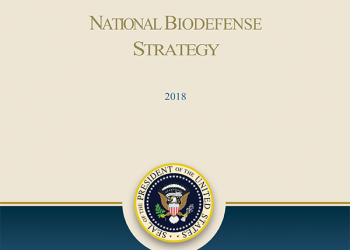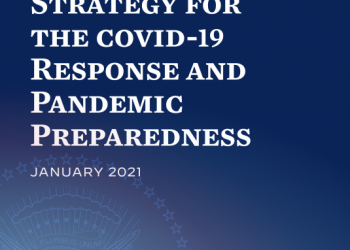The National Association of County and City Health Officials (NACCHO) represents the nation’s nearly 3,000 local government health departments. These city, county, metropolitan, district, and tribal departments work every day to protect and promote the health and well-being of all people within their communities.1 As chief health strategists, local health departments (LHDs) must be empowered to cultivate relationships with community partners and ensure operational plans for an all-sector response before a crisis.
In NACCHO’s 2018 Preparedness Profile Assessment, a semi-annual assessment of its members, 41% of preparedness coordinators were aware of the National Health Security Strategy (NHSS).2,3 Of those who were aware of the NHSS, 74% reported the approach at least somewhat informed their preparedness work.2 As the backbone of the public health system in the United States, LHDs have been the boots on the ground to deliver response and mitigation efforts throughout the Coronavirus Disease 2019 (COVID-19) pandemic. The pandemic has highlighted numerous ways that LHDs are a key part of our nation’s health security infrastructure and provided lessons on what more is needed. The 2023-2026 NHSS presents an opportunity to build on lessons learned and advance public health preparedness priorities in a post-COVID-19 environment.
In September 2021, NACCHO’s Preparedness Policy Advisory Group identified the following top national health security areas for improvement:
- Coordination across all response partners
- Addressing a full health security spectrum
- Strengthening domestic response capacity (e.g., public health infrastructure, workforce, and authority)
- Improving interoperability of data systems, integration, and security
- Addressing climate change
- Promoting health equity
- Strengthening supply chain resilience
Coordination Across All Response Partners
There is a need to improve the coordination across all levels of response partners in order to develop strategies both before and during responses. Visibility of resources should include local partners to ensure coordination at the local level is responsive and nimble in a rapidly evolving response environment. The needs of local communities vary across the country and representation of their unique needs should be included in the decision making, implementation, and evaluation of planning and response efforts.
Addressing a Full Health Security Spectrum
It is crucial to focus on the delivery of critical medical innovations and the role public health plays in driving demand and community acceptance of innovations (e.g., vaccines and other medical countermeasures). Prioritizing efforts to build community trust and outreach before crisis hits benefits response measures.
Strengthening Domestic Response Capacity
The public health infrastructure has seen a 30% decrease of expenditures per capita between 2008 and 2019. Additionally, the local public health workforce capacity has decreased 21% since 2008. Investments are needed to support and sustain the public health workforce as pandemic recovery begins to ensure the nation is better positioned for future large-scale emergencies.4
Improving Interoperability of Data Systems, Integration, and Security
Les Becker, Deputy Secretary of Innovation for the Washington State Department of Health, stated during a 2021 Senate Committee on Health, Education, Labor and Pensions hearing that the current public health data system is “decrepit and disparate.”5 Key gaps resulting from this system are tracking capabilities for testing and vaccination records, health system capacity, and cybersecurity threats. Improvements are crucial for future response efforts. Priorities should focus on support for the interoperability of systems across all levels; improvement of cross-jurisdictional data sharing; and investment in public health data modernization at all levels (federal, state, and local).5
Addressing Climate Change
Climate-related disasters have a significant impact on public health and increase in severity and intensity year to year. No community is safe from the impact of these events, which cost the nation billions of dollars, lead to loss of life, uproot families, and elevate the disparity of health equity. National and global efforts to address climate change must be recognized.6
Promoting Health Equity
Health and social disparities result in a disproportionately higher burden of disease and impact from health security events. Investments are needed to support community-level outreach to build trust and bridge the gap between LHDs and community members. Planning activities should leverage data and include representatives of at-risk populations to better inform mitigation and response strategies.7
Strengthening Supply Chain Resilience
The COVID-19 pandemic has highlighted gaps in the strategic national stockpile strategy and the ability to quickly ramp up private sector supplies leaving communities and healthcare systems without the personal protective equipment and supplies needed to adequately respond. Although advances were made to address many of the shortages experienced early in the pandemic, there is still a need to evaluate strategies of maintaining inventories at all levels of the government.
As the 2023-2026 NHSS is being developed, ASPR is looking for input from local health departments and other public health stakeholders on the following questions. Please note that you are not limited to the questions below and additional feedback is welcome.
- What are the most critical national health security threats and public health and medical preparedness, response, and recovery challenges that warrant increased attention over the next five years?
- What medium-term and long-term (i.e., over the next five years) actions should be taken to mitigate these challenges at the federal government and/or state, local, tribal, and territorial level?
- What are the most critical public health and medical preparedness, response, and recovery opportunities or promising practices that should be capitalized on over the next five years?
- How can national strategies such as the NHSS better inform and support your work?
If you represent a local health department in your area and would like to submit feedback, email [email protected] with the subject line “2023-2026 NHSS input.” Comments may be placed in the body of the email or in an attachment to the email using a standard document format.
This article is the final in a series of articles aimed to provide education regarding key national health security concerns such as new and evolving 21st century health threats, federal government mitigation strategies used to support state, local, tribal, and territorial authorities, and future health security priorities. To learn more, please refer to the previous articles in this series listed below:
- Introduction to the NHSS and NBS
- Health Security Threat Landscape and the Effects of COVID-19
- Key Accomplishments and Priorities of the NBS
- Examining the National Health Security Strategy Through a Local Health Department Lens
- Health Security Issues of Concern from the Federal Government Perspective
Authors:
Shanlynn Bias, MPH
Program Analyst, Preparedness
Kathy Deffer
Director of Preparedness
Adriane Casalotti, MPH, MSW
Chief of Government and Public Affairs
References:
1. National Association of County and City Health Officials (NACCHO). NACCHO webpage. Retrieved on November 22, 2021, from https://www.naccho.org/
2. NACCHO. December 2018. The Public Health Emergency Preparedness Landscape: Findings from the 2018 Preparedness Profile Assessment. Retrieved on November 22, 2021, from https://www.naccho.org/uploads/downloadable-resources/2018-Preparedness-Profile-Report_external_final.pdf
3. U.S. Department of Health & Human Services, Office of the Assistant Secretary for Preparedness and Response. National Health Security Strategy (NHSS). Retrieved on November 22, 2021, from: https://www.phe.gov/Preparedness/planning/authority/nhss/Pages/default.aspx
4. NACCHO. February 2021. President Jennifer Kertanis Testified Before Congress on Public Health Infrastructure and Workforce Issues. Retrieved on November 23, 2021, from: https://www.naccho.org/blog/articles/naccho-president-jennifer-kertanis-testified-before-congress-on-public-health-infrastructure-and-workforce-issues
5. NACCHO. July 2021. Senate HELP Committee Holds Hearing on Rebuilding Public Health Infrastructure. Retrieved on November 23, 2021, from: https://www.naccho.org/blog/articles/senate-help-committee-holds-hearing-on-rebuilding-public-health-infrastructure
6. NACCHO. April 2019. NACCHO Sends Letter to House Oversight Committee Highlighting Public Health Effects of Climate Change. Retrieved on November 23, 2021, from: https://www.naccho.org/uploads/downloadable-resources/Climate-Change-Hearings-Release_4.29.2019.pdf
7. NACCHO. NACCHO Exchange Winter 2021: Health Equity. March 2021. Retrieved on November 23, 2021, from: https://www.naccho.org/blog/articles/naccho-exchange-winter-2021-health-equity




